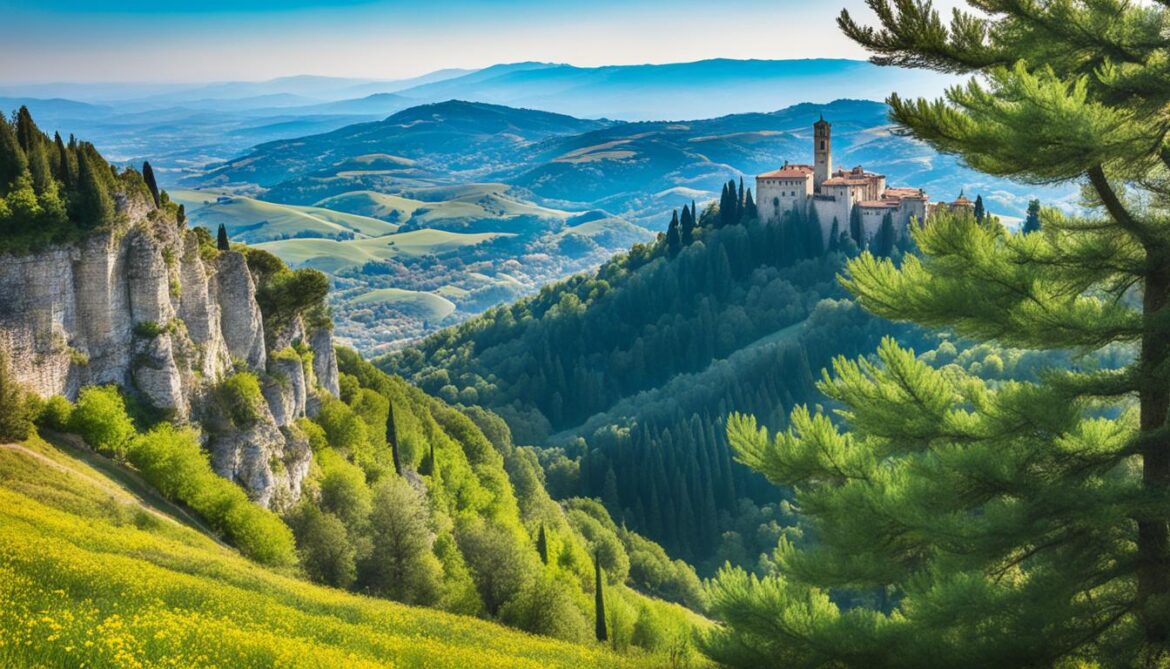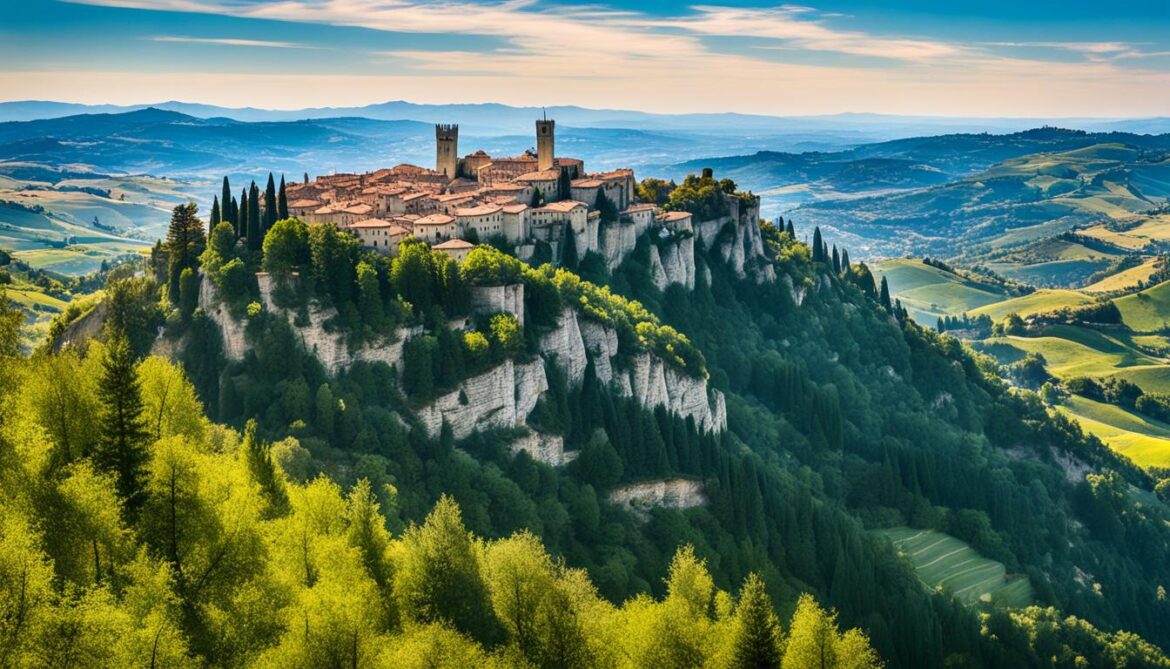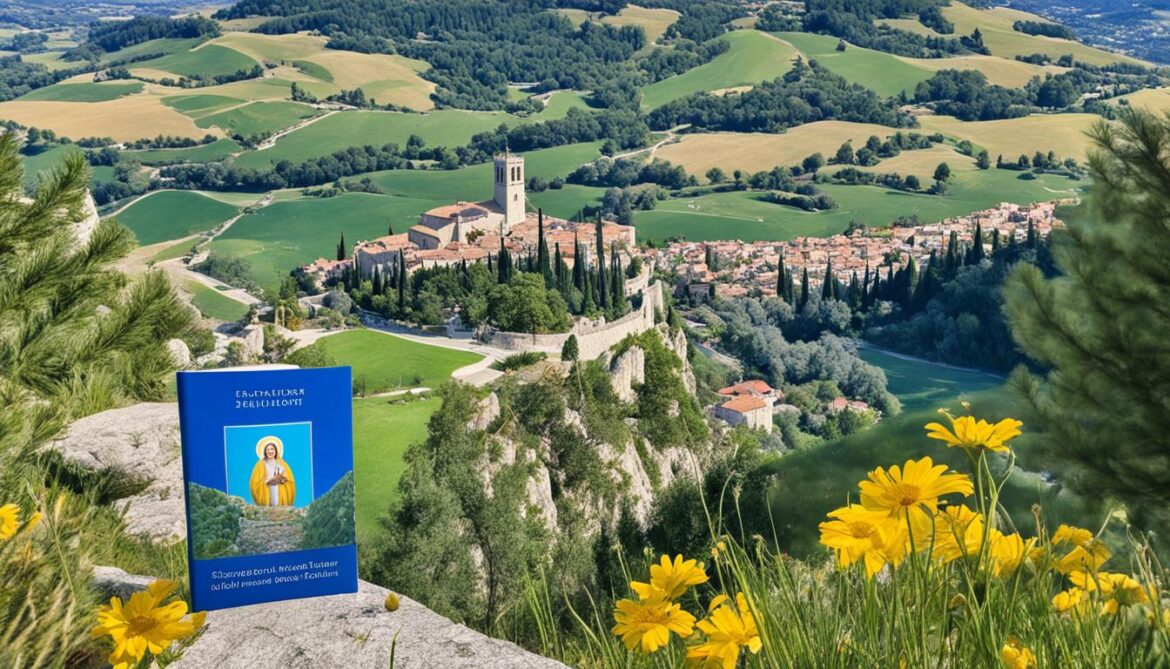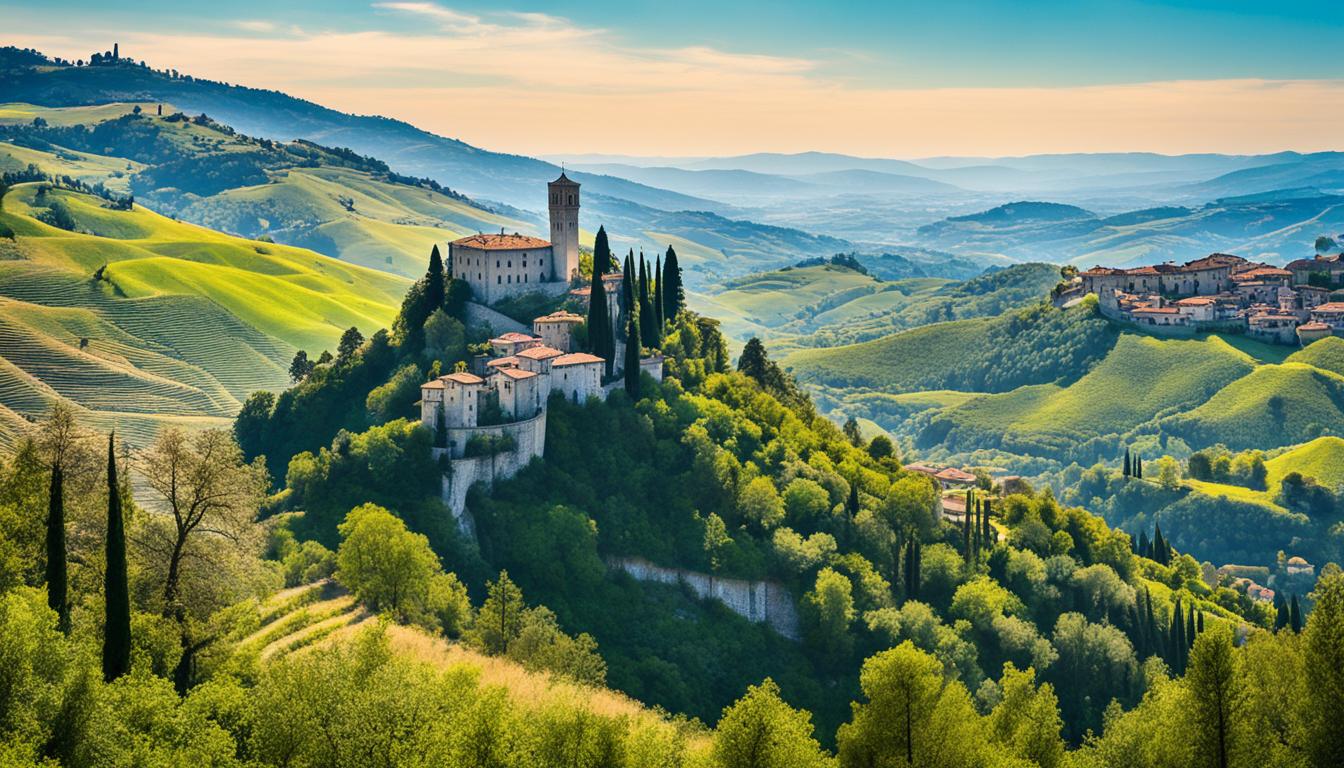Did you know that San Marino, the charming microstate nestled within Italy, is home to sacred natural sites that hold immense biodiversity? These sites are not only environmentally significant but also culturally and spiritually revered. The conservation efforts undertaken by San Marino to protect these sacred natural sites and preserve its biodiversity are commendable and set an example for the world.
Key Takeaways:
- San Marino houses sacred natural sites that boast rich biodiversity.
- Conservation efforts in San Marino aim to protect both the environment and cultural heritage.
- San Marino’s initiatives demonstrate a commitment to sustainable management practices.
- The deep connection between faith, nature, and culture is evident in Marian popular devotions.
- San Marino’s efforts contribute to global conservation initiatives.
San Marino’s Historic Centre and Mount Titano
San Marino’s Historic Centre and Mount Titano have implemented various initiatives to promote the conservation and management of the site. These include an annual ceremony commemorating the inscription, didactical programmes, training courses, subsidized loans for citizens, and provisions regulating waste management. Additionally, the development of new cultural information panels aims to provide comprehensive information on the monuments of the property in both Italian and English. This initiative helps to harmonize cultural and tourist information and is also used for official and institutional visits.
One of the key practices in preserving the San Marino Historic Centre and Mount Titano is the annual ceremony that marks the inscription of the property. This event serves as a symbolic reminder of the significance of the site and the ongoing commitment to its conservation. It also creates a sense of pride and awareness among the local community and visitors.
Furthermore, didactical programmes and training courses are offered to educate the public and stakeholders about the importance of preserving the site’s historical and cultural heritage. These initiatives aim to raise awareness and promote responsible tourism practices, ensuring that visitors understand and respect the site’s values and significance.
Subsidized loans are provided to citizens to support the maintenance and renovation of properties within the Historic Centre. This financial assistance encourages the local community to actively participate in the preservation efforts and ensures the long-term sustainability of the site.
“The development of new cultural information panels is another significant step in promoting the conservation and management of the San Marino Historic Centre and Mount Titano. These panels provide valuable information about the monuments and structures within the property, enhancing the visitor experience and fostering a deeper understanding of San Marino’s rich cultural heritage,” said Maria Rossi, a cultural heritage expert.
In addition to preserving the cultural aspects, San Marino also focuses on waste management within the Historic Centre and Mount Titano. Provisions have been put in place to regulate waste disposal and ensure the cleanliness of the site. This commitment to environmental sustainability is part of the overall strategy to maintain the integrity and beauty of the property.
San Marino’s Preservation Initiatives
| Initiative |
Description |
| Annual Ceremony |
Commemorates the inscription of the Historic Centre and Mount Titano, emphasizing the site’s significance and the commitment to its conservation. |
| Didactical Programmes and Training Courses |
Educational initiatives to raise awareness and promote responsible tourism practices, ensuring visitors understand the site’s cultural heritage. |
| Subsidized Loans |
Financial assistance provided to citizens for the maintenance and renovation of properties within the Historic Centre, encouraging active participation in preservation efforts. |
| Cultural Information Panels |
Development of comprehensive panels in Italian and English to provide detailed information on the monuments and enhance the visitor experience. |
| Waste Management Provisions |
Policies and regulations to regulate waste disposal and ensure the cleanliness of the site, contributing to environmental sustainability. |
Protected Naturalistic Areas of the Republic of San Marino
The Protected Naturalistic Areas of the Republic of San Marino play a significant role in the preservation of biodiversity and the protection of the environment. These areas are home to a diverse range of plant and animal species, contributing to the overall natural heritage of San Marino. It is crucial to recognize these areas as valuable resources that require attention and responsible access by citizens and visitors alike.
The protection of nature in these areas is not merely a choice; it is a duty and a sign of civil maturity. The establishment of protected areas helps to strike a balance between human activities and the harmonious coexistence of various ecosystems. By safeguarding these naturalistic areas, San Marino ensures the long-term sustainability and richness of our planet’s biodiversity.
The efforts in preserving the Protected Naturalistic Areas of San Marino contribute to the overall conservation and environmental protection of the country. These areas serve as natural sanctuaries, providing habitats for endangered species and serving as breeding grounds for native flora and fauna. They also offer opportunities for scientific research and education, allowing us to deepen our understanding of ecological systems and promote sustainable practices.
Biodiversity Conservation in San Marino
Biodiversity preservation is at the core of the conservation efforts in San Marino. The Protected Naturalistic Areas serve as crucial sites for safeguarding and promoting biodiversity. These areas are carefully managed to protect endemic species, maintain ecological balance, and preserve the delicate relationships between different organisms within the ecosystems.
San Marino’s commitment to biodiversity conservation extends beyond the Protected Naturalistic Areas. The country has implemented various initiatives and policies to raise awareness and promote sustainable practices among its citizens. By involving the local community in conservation efforts and providing educational programs, San Marino ensures that the importance of biodiversity preservation is understood and embraced by all.
“The protection of nature is a fundamental aspect of sustainability. By preserving our natural heritage, we lay the foundation for a more resilient and harmonious future.” – [Author Name]
Environmental Protection in San Marino
San Marino recognizes the critical role that environmental protection plays in the overall well-being of its citizens. By preserving and managing the Protected Naturalistic Areas, the country actively contributes to the mitigation of climate change, the protection of water resources, and the maintenance of healthy ecosystems.
Environmental protection in San Marino goes beyond the boundaries of the protected areas. The country has implemented sustainable waste management practices, renewable energy initiatives, and strict regulations on industrial activities to minimize the impact on the environment. These measures demonstrate a comprehensive approach to conserving and protecting the natural environment for present and future generations.
The commitment to environmental protection in San Marino is not only a testament to the country’s dedication to sustainability but also a source of inspiration for other nations striving to achieve a greener and more ecologically conscious future.

| Benefits of Protected Naturalistic Areas in San Marino |
Actions for Biodiversity Preservation and Environmental Protection |
| 1. Conservation of endangered species |
1. Public awareness campaigns |
| 2. Protection of unique ecosystems |
2. Sustainable waste management practices |
| 3. Preservation of genetic diversity |
3. Promotion of renewable energy initiatives |
| 4. Research and scientific study opportunities |
4. Implementing strict regulations on industrial activities |
| 5. Conservation education and awareness |
5. Collaboration with local communities |
Recognition of Best Practice in World Heritage Management
The Recognition of Best Practice in World Heritage Management is an initiative that aims to identify and promote successful and sustainable management practices in World Heritage sites. This initiative encourages states and site managers to reflect on their management practices and explore improvement possibilities.
Successful and sustainable management practices can include:
- Involving local communities: Engaging local communities in the decision-making process and ensuring their participation in the conservation and preservation of World Heritage sites can lead to a sense of ownership and responsibility.
- Creating innovative policies: Developing and implementing innovative policies that address the challenges of preserving and managing World Heritage sites can contribute to their long-term sustainability.
- Regulating tourism: Managing tourism activities and implementing measures to protect the integrity of World Heritage sites, while also providing visitors with meaningful experiences, is essential for their conservation.
- Implementing conservation measures: Applying effective conservation measures, such as restoring and preserving important historical structures, protecting natural habitats, and managing cultural landscapes, plays a crucial role in ensuring the sustainability of World Heritage sites.
By sharing these best practices, World Heritage sites can learn from one another, find solutions that work, and contribute to the overall conservation efforts. The Recognition of Best Practice in World Heritage Management acknowledges and encourages the implementation of successful strategies that prioritize the conservation of these unique and significant sites for future generations.

“Sustainable management practices are crucial for preserving the outstanding universal value of World Heritage sites while safeguarding their authenticity and integrity.” – Dr. Maria Rodriguez, World Heritage Expert
World Heritage Committee’s Inscriptions
The World Heritage Committee plays a crucial role in preserving and protecting cultural and natural sites of outstanding universal value. Each year, the committee inscribes new sites on UNESCO’s World Heritage List, recognizing their significance and promoting their conservation. In the 32nd session, held recently, a total of 27 sites were added to the list, further enriching our global heritage.
San Marino’s First Inscription
Among the countries whose sites were inscribed for the first time was San Marino, a small republic embraced by Italy. This remarkable achievement marks a milestone in the country’s cultural and natural landscape. San Marino’s inscription showcases its commitment to preserving and celebrating its unique heritage.
Diverse Cultural and Natural Sites
The newly inscribed sites include 19 cultural sites and eight natural sites. These sites encompass a wealth of rich history, magnificent architecture, and breathtaking natural landscapes. From ancient archaeological wonders to stunning natural wonders, these sites represent the incredible diversity of our world’s heritage.
Expanding the World Heritage List
With these latest inscriptions, the World Heritage List now encompasses a total of 878 sites from 145 countries. These sites range from iconic landmarks and historic towns to pristine natural reserves and exceptional ecosystems. Each site tells a unique story and contributes to our collective human experience.
Preserving Our Cultural and Natural Treasures
“Inscriptions on the World Heritage List are not just a recognition of outstanding value but also an international commitment to protect and preserve these treasures for future generations. They remind us of the importance of safeguarding our shared history, culture, and natural heritage.” – UNESCO Director-General
The inscriptions by the World Heritage Committee validate the exceptional value of these cultural and natural sites. They serve as a powerful reminder of our responsibility to ensure their long-term preservation and sustainable management.
Newly Inscribed Sites
| Type |
Country |
Site |
| Cultural |
San Marino |
San Marino Historic Centre and Mount Titano |
| Cultural |
India |
Dholavira: A Harappan City |
| Natural |
Iceland |
Vatnajökull National Park – Dynamic Nature of Fire and Ice |
| Natural |
New Zealand |
Shetland Islands |
The newly inscribed sites reflect the incredible depth and range of our world’s cultural and natural heritage. They are a testament to our shared commitment to protecting and preserving these treasures for future generations to discover and appreciate.

The Sacredness of Nature and Conservation
The sacredness of nature has always been acknowledged as a fundamental aspect of conservation efforts. Throughout history, sacred natural sites have been entrusted to the care and management of indigenous communities who recognize their inherent value. These sites play a critical role in preserving ecosystems and safeguarding biodiversity, often serving as repositories of traditional knowledge and practices.
Indigenous conservation practices reflect a profound understanding of the interconnections between nature, culture, and spirituality. They recognize that the well-being of the environment is intrinsically linked to the well-being of communities. These practices prioritize sustainable resource management, harmonious coexistence with the natural world, and the preservation of cultural heritage.
“Indigenous peoples’ values, religious beliefs, and management practices are now seen as important components of effective community-based natural resource management.”
The conservation of sacred natural sites not only ensures the protection of specific places but also contributes to the broader concept of “biocultural diversity.” These sites are often managed with greater care and attention, resulting in the preservation of unique habitats and species diversity. Their existence is a testament to the successful integration of environmental stewardship and cultural practices.
Recognizing the importance of indigenous conservation practices, partnerships between religious and conservation groups have emerged. By harnessing the shared values of sacredness and reverence for nature, these collaborations have the power to mobilize communities, advocate for conservation policies, and galvanize action towards sustainable development.
Conservation through Shared Values
Engaging indigenous communities in conservation initiatives not only empowers them but also taps into their wealth of traditional knowledge. This knowledge, passed down through generations, offers valuable insights into sustainable resource management, ecosystem dynamics, and climate adaptation.
Through inclusive and participatory approaches, conservation programs can benefit from the wisdom and deep connection to nature that indigenous communities possess. By acknowledging and respecting the sacredness of these sites, we can forge partnerships that are rooted in cultural sensitivity, environmental justice, and shared aspirations for a sustainable future.
| Conservation Practices |
Key Benefits |
| Traditional land-use management |
Promotes sustainable resource utilization and minimizes ecological disruption |
| Sacred site protection |
Preserves unique habitats and safeguards biodiversity |
| Traditional ecological knowledge |
Provides insights for climate adaptation and ecosystem stewardship |

The sacredness of nature and the conservation of sacred natural sites are not isolated efforts but part of a broader movement towards sustainable development. As we recognize and appreciate the spiritual significance of these sites, we can foster a deeper connection to the natural world and inspire collective action in safeguarding our planet.
Marian Popular Devotions and the Religious Significance of Plants
Marian popular devotions hold a special place in the hearts of believers, particularly in Spain. These devotions not only deepen the spiritual connection between individuals and the divine but also celebrate the profound bond between faith and the natural world. Through the practice of Marian popular devotions, believers are transformed in the way they see, interact with, and value the natural world around them.
One remarkable aspect of Marian popular devotions in Spain is the use of verdant titles, naming advocations after plants and trees. This practice reflects the deep association between Mary and the natural environment. These advocations, often originating from private revelations, have become an integral part of the cultural heritage of communities, imparting a sense of reverence for both the religious and natural realms.
“The figure of Mary mediates the encounters between the divine and the humble individual, blurring the line between the transcendent and immanent.”
The figure of Mary, in these devotions, serves as a mediator between the divine and the individual. This unique connection blurs the line between the transcendent and immanent, emphasizing the interconnectedness of all creation. Through Marian popular devotions, believers come to understand and appreciate the religious significance of the natural world, viewing it not merely as a backdrop but as a sacred manifestation of God’s love and presence.
For believers, the religious significance of plants in Marian popular devotions is a powerful reminder of the beauty, diversity, and interconnectedness of the natural world. It encourages a profound respect for the environment and the need to protect and preserve it for future generations. The deep-rooted connection between faith, nature, and cultural heritage is exemplified in these devotions, inviting believers to reflect on their role as stewards of God’s creation.
Marian Popular Devotions and Environmental Stewardship
The practice of Marian popular devotions, with its emphasis on the religious significance of plants, has the potential to inspire environmental stewardship. By recognizing the intrinsic value of the natural world and its interconnectedness with faith, believers are encouraged to adopt sustainable practices and become advocates for environmental conservation.
This connection between religion and nature is not unique to Marian devotions in Spain but can be found in traditions worldwide. Indigenous communities have long recognized the sacredness of nature and developed conservation practices rooted in their spiritual beliefs. By acknowledging the religious significance of plants, Marian popular devotions align with these indigenous conservation practices, emphasizing the importance of nurturing and protecting the natural world.
Through the integration of ecotheology and faith-based environmental education, Marian popular devotions can play a significant role in promoting environmental awareness and sustainable living. These devotions provide opportunities for believers to reflect on their own connection with nature and consider how their actions impact the environment.
A deeper understanding of the religious significance of plants in Marian devotions may inspire believers to engage in eco-friendly practices, such as supporting local conservation efforts, practicing responsible consumption, and participating in environmental initiatives. By harnessing the transformative power of faith and the appreciation for the natural world, Marian popular devotions have the potential to create a profound impact on environmental stewardship.
The Intersection of Faith and Nature
As believers engage in Marian popular devotions and reflect on the religious significance of plants, they are invited to see the natural world not as a mere resource to be exploited but as a sacred gift to be cherished. This intersection of faith and nature encourages individuals to cultivate a sense of wonder, awe, and reverence for the wonders of creation.
This profound connection between faith and nature can inspire believers to see themselves as caretakers of the Earth, entrusted with the responsibility of preserving its beauty and diversity for future generations. By valuing and protecting the natural world, believers honor the divine presence in all living beings and contribute to the wider effort of environmental conservation.
Marian popular devotions go beyond religious rituals; they provide a space for believers to deepen their connection with the natural world. These devotions invite individuals to find solace, inspiration, and spiritual growth in the beauty of plants and the wonder of creation.
As the religious significance of plants in Marian devotions continues to be celebrated and explored, believers are given a unique opportunity to embrace their role as caretakers of the Earth and discover the profound spiritual lessons that nature offers.

The Role of Trees in Marian Devotions
Trees play a significant role in Marian devotions, particularly in Spain. They serve as powerful symbols in religious imagery, representing both transcendence and boundaries. The tree of life motif, present in various religious traditions, embodies the idea of eternal life and spiritual growth.
In popular Catholicism, trees hold deep significance. They are seen as an indestructible, life-giving force that mediates the presence of the divine. Trees symbolize the connection between heaven and earth, serving as conduits for spiritual energy.
Many rural Marian advocations in Spain are associated with forests or caves, where hidden images of Mary were discovered or apparitions occurred. These sacred locations evoke a profound sense of spirituality and awe. They signify the intimate connection between trees, nature, and the spiritual realm.
“The tree of life resembles the image of Mary, who brings forth spiritual fruit, nurtures and sustains life, and provides shelter and refuge.”
The reverence for trees in Marian devotions reflects the profound respect for the natural world within the Catholic faith. It is a reminder of the interconnectedness between spirituality and the environment, emphasizing the importance of caring for God’s creation.
The Symbolism of Trees in Marian Devotions
Throughout Christian history, trees have been used as powerful symbols in religious imagery. They represent growth, strength, and rootedness in faith. Just as trees are deeply rooted in the earth, believers are encouraged to deepen their spiritual connection with the divine.
Additionally, trees symbolize the fertility and nourishment of the soul. They provide shade and shelter, representing Mary’s role as the Mother of Mercy who offers comfort and protection to her followers.
The significance of trees in Marian devotions extends beyond their physical presence. They serve as reminders of the spiritual journey, inviting believers to reflect on their own growth and the ever-present presence of Mary in their lives.
The Environmental Message of Marian Devotions
Marian devotions not only emphasize the role of trees in religious imagery but also carry an important environmental message. By incorporating trees and nature into religious practices, believers are encouraged to appreciate and care for the natural world.
These devotions foster a sense of responsibility and stewardship towards the environment. They reinforce the idea that all of creation is sacred and should be treated with reverence and respect.
Through the symbolism of trees in Marian devotions, believers are reminded of the interconnectedness between spirituality, nature, and the protection of God’s creation. This message carries profound implications for environmental conservation and sustainability.

| Symbolism of Trees in Marian Devotions |
Environmental Message |
| Trees represent growth, strength, and rootedness in faith. |
Marian devotions foster an environmental message of reverence and respect for creation. |
| Trees symbolize Mary’s role as the Mother of Mercy, providing comfort and protection. |
Marian devotions promote a sense of responsibility and stewardship towards the environment. |
| Trees serve as reminders of the spiritual journey and Mary’s presence in believers’ lives. |
Through their symbolism, trees highlight the interconnectedness between spirituality, nature, and conservation. |
Conclusion
San Marino understands the significance of preserving sacred natural sites and biodiversity. With its initiatives in managing the Historic Centre and Mount Titano and establishing protected naturalistic areas, the country showcases its commitment to conservation and environmental protection. The recognition of best practices in World Heritage management further underscores the value of sustainable approaches. An exceptional connection between faith, nature, and cultural heritage can be witnessed in the Marian popular devotions, where the admiration for plants and trees is apparent. San Marino’s dedicated efforts in safeguarding its sacred natural sites and biodiversity significantly contribute to global conservation efforts.
FAQ
What initiatives have been implemented to promote the conservation of San Marino’s Historic Centre and Mount Titano?
The initiatives implemented include an annual ceremony commemorating the inscription, didactical programmes, training courses, subsidized loans for citizens, provisions regulating waste management, and the development of new cultural information panels.
What is the purpose of the development of new cultural information panels?
The development of new cultural information panels aims to provide comprehensive information on the monuments of the property in both Italian and English. This helps to harmonize cultural and tourist information and is also used for official and institutional visits.
How do the Protected Naturalistic Areas of the Republic of San Marino contribute to biodiversity preservation and environmental protection?
The Protected Naturalistic Areas of San Marino play a significant role in biodiversity preservation and environmental protection. These areas are rich in biodiversity and contribute to the overall natural heritage of San Marino. They are considered a valuable resource that deserves attention and respectful access by citizens.
What is the purpose of the Recognition of Best Practice in World Heritage Management initiative?
The Recognition of Best Practice in World Heritage Management aims to identify and promote successful and sustainable management practices in World Heritage sites. This initiative encourages states and site managers to reflect on their management practices and explore improvement possibilities.
How many sites were added to UNESCO’s World Heritage List in the 32nd session?
In the 32nd session, 19 cultural sites and eight natural sites were added to UNESCO’s World Heritage List.
How do sacred natural sites contribute to biodiversity preservation?
Sacred natural sites, often managed by indigenous communities, have played a vital role in the preservation of ecosystems and biodiversity. These sites have been more carefully preserved than surrounding areas and have contributed to the maintenance of “biocultural diversity.”
What is the significance of Marian popular devotions in relation to nature?
Marian popular devotions, particularly in Spain, play a significant role in the religious and cultural practices associated with nature. Many Marian advocations in Spain are named after plants and trees, reflecting the deep connection between faith and the natural world.
What is the symbolic role of trees in Marian devotions?
Trees have a significant role in Marian devotions, particularly in Spain. The tree of life motif, present in various religious traditions, symbolizes both transcendence and boundaries. In popular Catholicism, trees represent an indestructible, life-giving force that mediates the presence of the divine.
What is the importance of preserving sacred natural sites and biodiversity in San Marino?
The preservation of sacred natural sites and biodiversity is of utmost importance for San Marino. The initiatives taken, such as the management of the Historic Centre and Mount Titano and the establishment of protected naturalistic areas, demonstrate a commitment to conservation and environmental protection.
























Post comments (0)